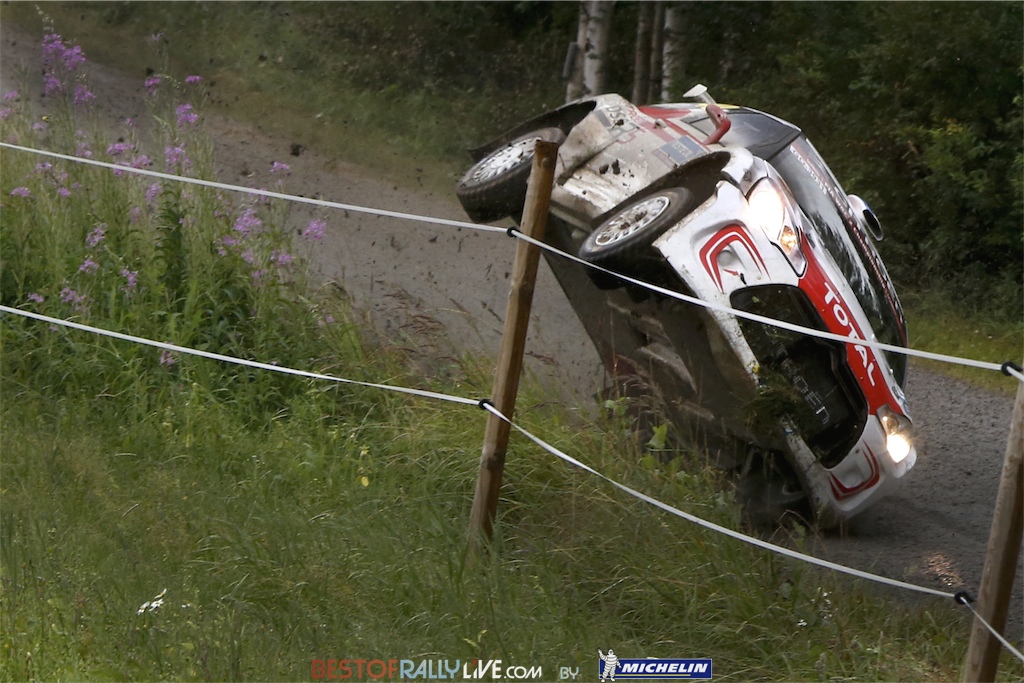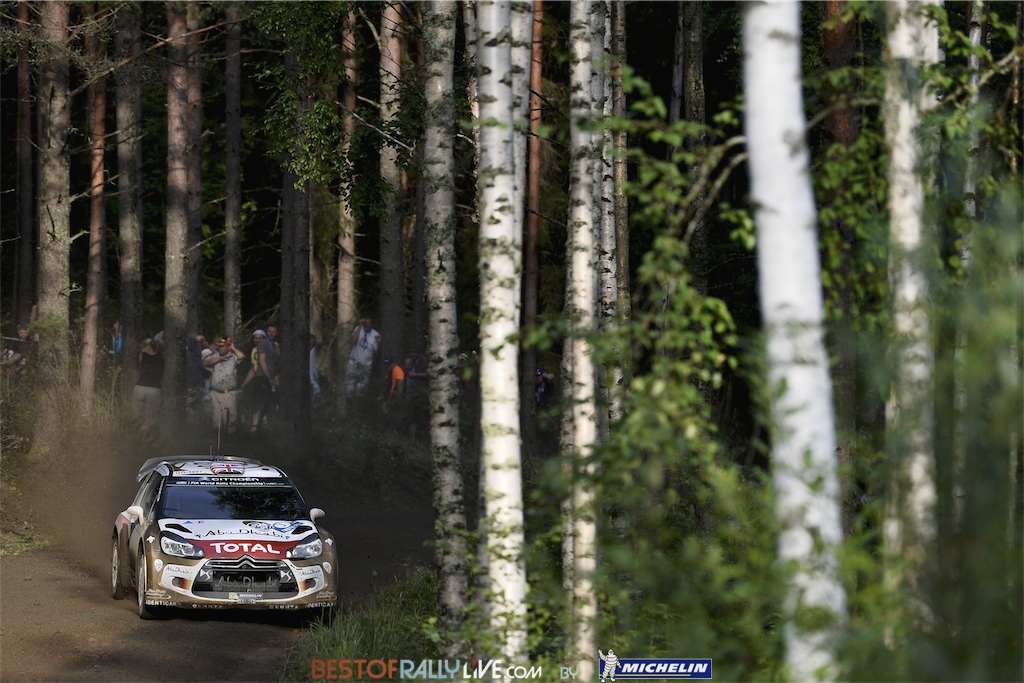
Pour la quatrième fois consécutive depuis l’Argentine, deux Volkswagen Polo R WRC/Michelin ont bouclé la première étape en tête. Jari-Matti Latvala devance Sébastien Ogier de 4s5. Kris Meeke (Citroën) est troisième à moins de 10 secondes.
Dans le second passage de Lankamaa (ES3, 23,44 km), Jari-Matti Latvala et Sébastien Ogier ont signé le même temps, à 125,7 km/h de moyenne sur des pistes creusées d’ornières par endroits. Et sept pilotes ont amélioré le record détenu depuis 11 ans par Marcus Grönholm…
Ceci témoigne du niveau très relevé du WRC actuel et de l’intensité de la bagarre entre les deux pilotes Volkswagen. « Il fallait réagir car Jari-Matti avait remporté les deux 1ères ES », racontait Ogier ce soir. « J’ai été assez prudent en début de rallye, je me méfiais des éventuelles flaques d’eau. Demain, on va attaquer, c’est sûr. Battre les Finlandais chez eux n’est jamais facile. »
Jari-Matti Latvala a maîtrisé son sujet aujourd’hui, malgré une petite chaleur à l’arrivée de la Superspéciale, Harju : « Dans le dernier droite en descente, il y avait un ballot de paille à l’intérieur. Je savais qu’il ne fallait pas prendre corde, mais j’avais oublié le ballot. J’ai freiné un peu tard et j’ai touché à l’avant-droit, mais sans conséquence. » Le Finlandais n’a perdu que 8/10e dans l’aventure et reste leader du rallye avec 4s5.
Kris Meeke figure sur le podium provisoire depuis la 1ère spéciale. Le pilote Citroën Racing dit avoir un bon feeling sur ces spéciales. « Il a toujours été très rapide ici », rappelle l’ingénieur Citroën Didier Clément, « l’an passé, on s’en souvient, mais aussi en Citroën C2 ».

En revanche, son équipier Mads Ostberg n’a jamais semblé très à l’aise avec sa DS3 WRC aujourd’hui. Le Norvégien pointe à la 7e place, à 3s7 de son compatriote Andreas Mikkelsen (VW, 6e). Les Finlandais Mikko Hirvonen (Ford, 4e) et Juho Hanninen (Hyundai, 5e) sont séparés par 7/10e de seconde. « C’était très bien dans les deux 1ères ES, mais la voiture était trop basse pour l’ES3 », a déclaré Juho.
Thierry Neuville, Robert Kubica et Hayden Paddon complètent le top-ten. En WRC-2, le leader Ott Tanak a perdu près de 5 minutes dans l’ES3 (crevaison). Jari Ketomaa (Ford Fiesta R5) est donc en tête avec une avance relativement confortable de 35 secondes sur Karl Kruuda (Ford). Eyvind Brynildsen (Ford) n’est qu’à 1s2 de l’Estonien. En WRC-3, Martin Koci (Citroën DS3 R3) a signé deux meilleurs temps et devance Stéphane Lefebvre de 27s5. Demain, la journée est chargée avec 9 spéciales au programme du côté de Jämsa.
For the fourth time in a row since Argentina, there are two Michelin-equipped Volkswagen Polo R WRCs sitting on top of the leaderboard after Day 1. Jari-Matti Latvala is 4.5s clear of Sébastien Ogier, while third-placed Kris Meeke (Citroën) is less than 10s behind.

The second visit to ‘Lankamaa’ (SS3, 23.44km), saw Latvala and Ogier post identical times, at an average speed of 125.7kph despite some deeply rutted portions. Meanwhile, seven drivers bettered the stage’s record that has been held for the past 11 years by Marcus Grönholm, a good indication of the performance of today’s WRC machines.
The anticipated battle between Volkswagen’s two stars has got off to a flying start. “I needed to respond after Jari-Matti won the first two stages,” related Ogier this evening. “I was quite cautious to begin with because I was concerned about coming across standing water. I intend to push tomorrow, but it’s never easy to beat the Finns in their own back garden.”
Latvala ended the day in front, despite a scare towards the end of the ‘Harju’ super-special. “There was a hay bale on the inside of the last downhill right-hander. I knew I couldn’t cut the corner but I forgot the hay bale. I braked a little late and there was impact at the front-right. Happily, there was no damage.” The Finn only dropped eight-tenths to Ogier who completed the day with a deficit of 4.5s.
Meeke has had a footing on the podium since SS1 and the Citroën Racing driver says he had a good feeling. “He’s always been fast here,” notes his engineer Didier Clément. “Not only last year but also in the Citroën C2.”
In contrast, the Ulsterman’s team-mate Mads Ostberg appeared unhappy in his DS3 WRC this afternoon. He is provisionally seventh, 3.7s adrift of fellow Norwegian Andreas Mikkelsen (6th, VW). Finns Mikko Hirvonen (4th, Ford) and Juho Hanninen (5th, Hyundai) are split by just seven-tenths of a second. “I was fine on the first two stages but my car was a little low for SS3,” commented the Hyundai driver.
Thierry Neuville, Robert Kubica and Hayden Paddon round off the top 10.
The early WRC-2 pace-setter Ott Tanak dropped almost five minutes with a puncture on SS3, handing first place to Jari Ketomaa (Ford Fiesta R5) who enjoys an overnight gap of 35s over Karl Kruuda (Ford), with Eyvind Brynildsen (Ford) a further 1.2s down.
In the WRC-3 fight, Martin Koci (Citroën DS3 R3) posted two fastest times to go 27.5s clear of Stéphane Lefebvre.

